Table of Contents
Will React Native mark the demise of Native App Development?
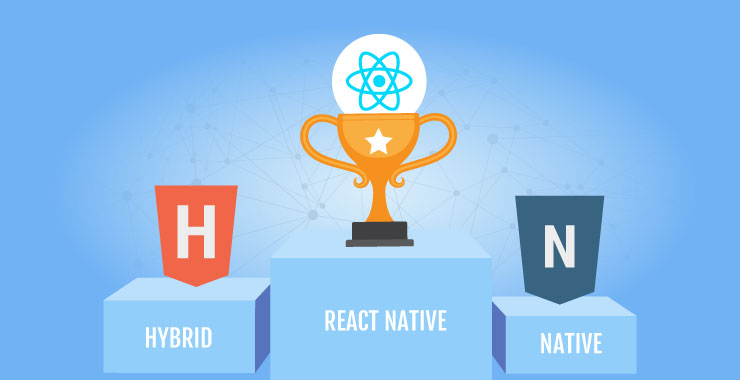
You can use your existing web development skills and can produce native iOS and Android app using those skills. It’s completely possible to utilize your HTML, CSS, and JavaScript skills to develop native Android and iOS apps.
I’m not talking about hybrid apps or just an app wrapper around a mobile website but actual native apps–pure, native apps that you design in iOS using Swift or in Android using Java or Kotlin. Thanks to React Native, native apps can now also be developed with common web technologies: HTML, CSS, and JavaScript.
If you still don’t believe me that these apps can be really be awesome. Take out your phone and have a look at one of these apps: Facebook, Messenger, Instagram, Skype, and Airbnb. They are developed in React Native.

What is React Native?
Facebook was facing a lot of problems about redesigning their apps and everything. The problem was handling many users and rolling out new features. Facebook needed something more robust, fasts that can handle a lot of traffic as well as can be designed really quickly. The brilliant team at Facebook started working on a JavaScript library, which came to known as React.
The best part is React employs faster virtual DOM. Although React is a library, lightweight component can be injected anywhere. You can use react with PHP, MySQL, Firebase, MongoDB or any database system of your choice.
You must be wondering isn’t React for designing web applications? Consider React Native as the successor of ReactJS for mobile app development. All the things that you learned in React like components props, States, Redux, Modal, etc. are part of React Native as well.
The things that you learned in React can be applied in React Native in the same workflow. Components, props and states are all used in react native and thus you got your native application.
The dual advantage of React Native
In React Native unlike native Java and Swift codes, you don’t ever compile your app. You just reload it just like do you a website in a web browser.
Moreover, you don’t have to maintain two separate codebases for your application. For example, let’s say you are a business and I am application development company whom you have outsourced a mobile app project.
Of course, you want an app for both Android and iOS in addition to the web. It requires two teams one for each mobile platform: one team for Android application and one team for iOS application. Those you aren’t aware implementing the same, exact features in iOS and Android app require a lot of communication exchange between those teams: app features, deadline, delivery, client expectation and requirements, etc.
Performance vs. Native Code
React Native apps perform, more or less, like an app written in Native iOS code. A Medium user ran a few tests to compare its performance with the native code and found performance at par with an equivalent app in Swift, sometimes even better. The Medium article measured performance in three areas: CPU, GPU and Memory utilization at the run time.
In CPU usage the performance was similar although maps performed better in Swift.
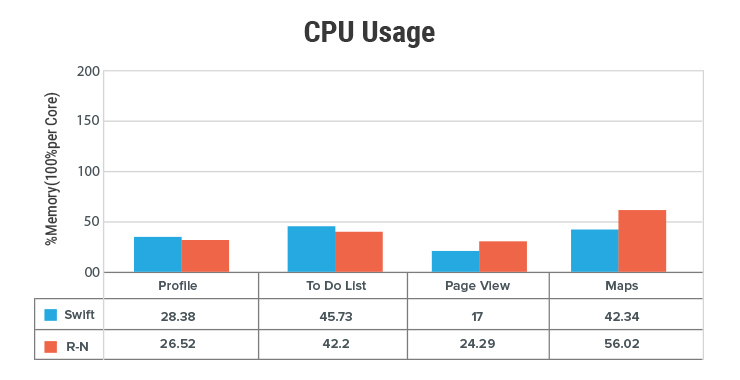
To calculate GPU performance, Native vs React Native, the author calculated frames per second (FPS) of the application under GPU load. Surprisingly, although by small margins, React Native outperformed Swift code by more 6.25 frames per second.
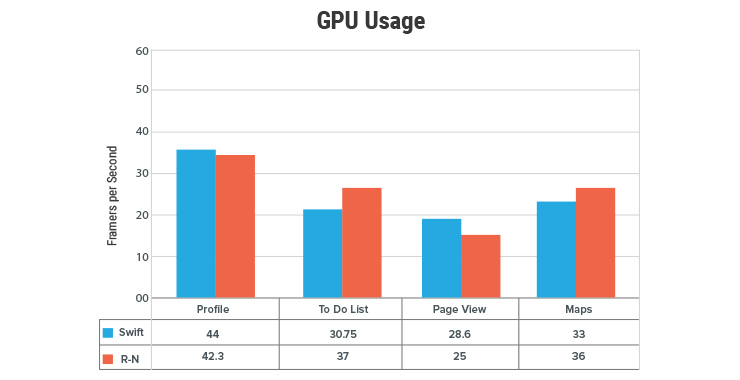
For memory tests, the author concentrated on maps as the memory footprints of other features was negligible to figure out a contrast. Evidently, at the peak performance, React Native used a whopping 61.11 MiB less memory than Swift. While performing the task and recording the measurements, a spike in Memory usage was observed at the exact moment, he pressed the “Maps” tab, which prompted the MapView to find my current location and highlight it with a blue, pulsating dot.
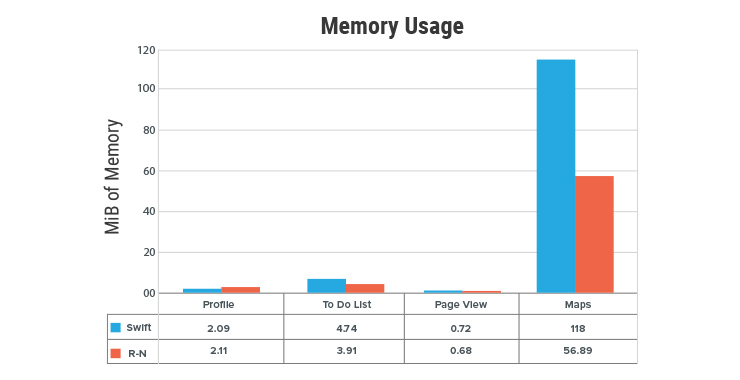
React Native is the smartest way to develop Mobile Apps
In the React Native, you just have to maintain a single codebase and that code will produce native Android app as well as iOS app. React Native is getting a lot of attention nowadays and people are loving how the things are shaping for React Native and the community is growing. You must be jumping on your couch. Finally, you can use cheaper web developers to design native Android and iOS app. You no more have to hire programmers or train them in Java, Kotlin, or Swift.
Is this the end of Native App development?
No, there existed always side-by-side technologies. Some businesses prefer React Native while others prefer native codes in Kotlin or Swift. It’s always good to have many mobile technologies around to choose from. Desktop application developers always had a lot of programming languages and technologies to choose from and most of them are still here, going strong.
For example, there are still apps that are being developed in Ruby on Rails, Django, PHP as well as node.js. Technologies evolve as per the demand.
The biggest takeaway of React Native is now there are more options than ever. Developers can go with Android development using Java or maybe Kotlin. Likewise, they can go for iOS development using Swift. With React Native, they have one more option to native development. Not to mention, now everyday web developers can also be part of native app development party.
The Tremendous Growth and the Future
Nevertheless, React Native is growing at a tremendous pace and if the growth sustains, soon, we will find more React Native developers than those into Swift or Kotlin development. This development in mobile ecosystem will mark a huge shift from the traditional form of mobile development. The field will evolve to absorb React Native development or any similar emerging or upcoming technologies into mobile app development.
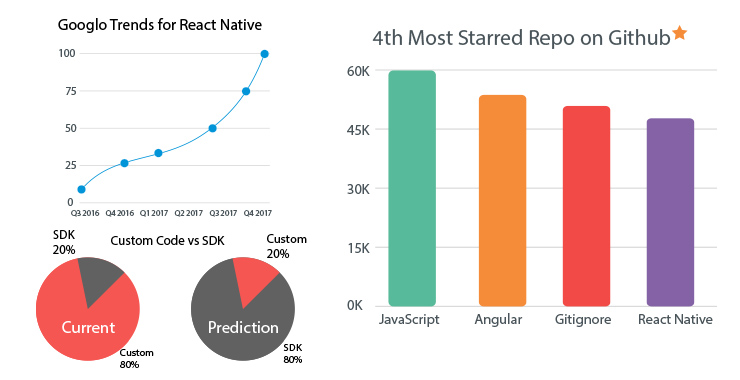
Google Trends is a popular tool to understand people’s interest in a search term. When used to forecast people interest in technology or a mobile development technique in this context, it can tell which of them are growing which are plummeting.
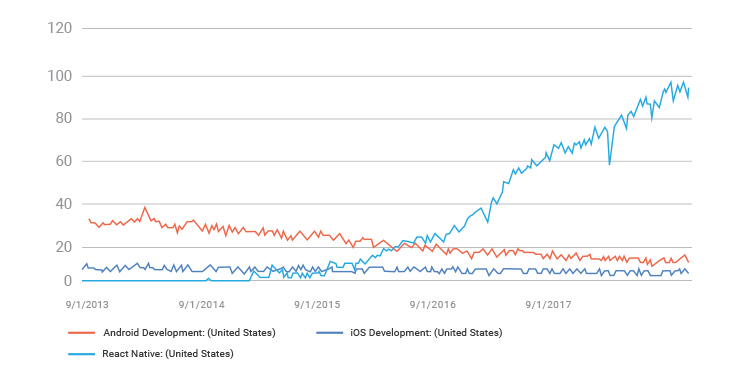
Source: Google Trends
Clearly, while React Native, as I said, has grown exponentially and iOS development has remained static, Android development has a seen a huge plunge. This made me think. Is the growth in React Native at the expense of Android development? It is too early to say but one thing is for sure: iOS development is here to stay while the future of Android because of React Native is in quite a disarray.
Android developers have a consistent complaint. They don’t earn as much as their iOS counterparts and the ROI is hard to come by. And the revenue gap is almost twice in a few demographics.
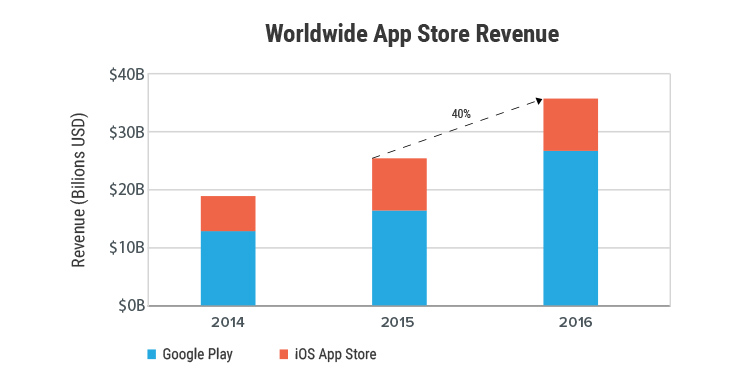
Source: App Annie
Perhaps, app platforms find React Native as the answers to their Android development vows.
Blurring lines between Android, iOS and Web development
The popularity of React Native and similar JavaScript frameworks are blurring the lines between web and mobile app developers. For the first in the history of mobile development, a developer can say I don’t want to learn Java or Objective C and still can build a mobile app.
For businesses looking to develop mobile apps, React Native brings a sea of opportunities. They can target both mobile platforms at the fraction of the cost. As businesses prefer iOS to Android for the reason I mentioned, React Native will give a new lease of life to Android development.
Tags

